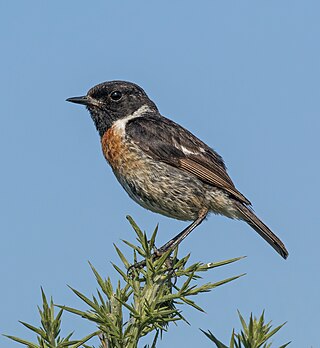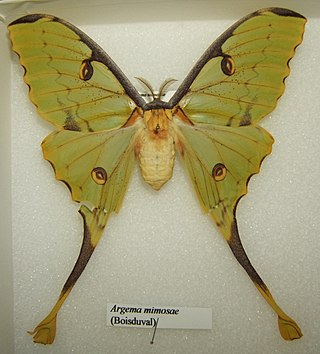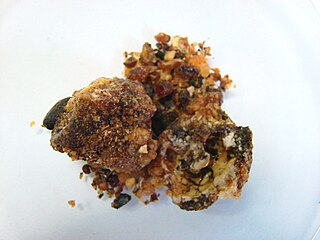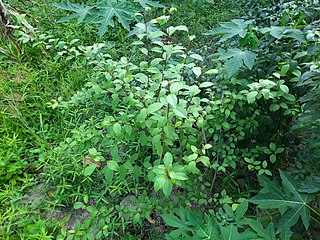
The whinchat is a small migratory passerine bird breeding in Europe and western Asia and wintering in central Africa. At one time considered to be in the thrush family, Turdidae, it is now placed in the Old World flycatcher family, Muscicapidae. Both sexes have a strong supercilium, brownish upper parts mottled darker, a pale throat and breast, a pale buff to whitish belly, and a blackish tail with white bases to the outer tail feathers, but in the breeding season, the male has an orange-buff throat and breast.

The European stonechat is a small passerine bird that was formerly classed as a subspecies of the common stonechat. Long considered a member of the thrush family, Turdidae, genetic evidence has placed it and its relatives in the Old World flycatcher family, Muscicapidae.

The Siberian stonechat or Asian stonechat is a recently validated species of the Old World flycatcher family (Muscicapidae). Like the other thrush-like flycatchers, it was often placed in the Turdidae in the past. It breeds in the East Palearctic including in easternmost Europe and winters in the Old World tropics.

Saxicola, the stonechats or chats, is a genus of 15 species of small passerine birds restricted to the Old World. They are insectivores occurring in open scrubland and grassland with scattered small shrubs.

The genus of the myrrhs, Commiphora, is the most species-rich genus of flowering plants in the frankincense and myrrh family, Burseraceae. The genus contains approximately 190 species of shrubs and trees, which are distributed throughout the (sub-) tropical regions of Africa, the western Indian Ocean islands, the Arabian Peninsula, India, and South America. The genus is drought-tolerant and common throughout the xerophytic scrub, seasonally dry tropical forests, and woodlands of these regions.

Banksia saxicola, the rock banksia or Grampians banksia, is a species of tree or shrub in the plant genus Banksia. It occurs in Victoria in two distinct populations, one in The Grampians and the other on Wilsons Promontory. Formerly considered to be a form of B. integrifolia, it was described as a distinct species by Alex George in 1981. It is most closely related to Banksia marginata.
Corkwood is a common name of a number of plants:

Commiphora wightii, with common names Indian bdellium-tree, gugal, guggal, guggul, gugul, or mukul myrrh tree, is a flowering plant in the family Burseraceae, which produces a fragrant resin called gugal, guggul or gugul, that is used in incense and vedic medicine. The species is native to southern Pakistan and western India. It prefers arid and semi-arid climates and is tolerant of poor soil.

Commiphora gileadensis, the Arabian balsam tree, is a shrub species in the genus Commiphora growing in Saudi Arabia, Yemen, southern Oman, Sudan and in southeast Egypt where it may have been introduced. Other common names for the plant include balm of Gilead and Mecca myrrh, but this is due to historical confusion between several plants and the historically important expensive perfumes and drugs obtained from them.

Argema mimosae, the African moon moth, is a giant silk moth of the family Saturniidae. Similar in appearance to the giant Madagascan moon moth, but smaller, this moth can be found widely in Eastern Africa and more locally in Southern Africa, including near the east coast of South Africa. The species was first described by Jean Baptiste Boisduval in 1847. An adult can measure 10 to 12 centimetres across its wingspan and 12 to 14 centimetres from head to the tip of its elongated tail-like second pair of wings. Its forward wings have a distinctive grey-coloured "furry" leading edge, giving a very rough surface, presumably for aerodynamic reasons. Apart from the eye-like markings on its wings, the colouring and shape of the wings give the appearance of a piece of foliage, especially the tail-like structures of the rearmost wings which resemble a dried out leaf stem - presumably for camouflage in its natural environment.

Thryptomene saxicola, commonly known as rock thryptomene, is a species of flowering plant in the family Myrtaceae and is endemic to the south-west of Western Australia. It is a spreading shrub with small oval or egg-shaped leaves and pale pink flowers arranged in leaf axils. It is hardy plant, common in cultivation, sometimes as "Payne's hybrid" or Thryptomene paynei.
Commiphora angolensis, also known as sand commiphora or sand corkwood, is a shrub species in the genus Commiphora growing mainly in Angola and Namibia.

Prostanthera saxicola is a species of flowering plant in the family Lamiaceae and is endemic to eastern Australia. It is a shrub with linear to elliptic leaves and white to mauve flowers arranged in leaf axils.

Commiphora caudata, the hill mango or green commiphora, is the most abundant Asian species of Commiphora of flowering plants in the frankincense and myrrh family, Burseraceae. It can be found in Southern India and Sri Lanka, usually growing in the full sun on hilly granite rock outcrops in dry zone areas. It is a small to medium-sized deciduous tree which is said to be able to reach height of 10-20m, but usually is less high. The tree has a smooth, succulent green bark, which partly flakes off with age, giving rise to a characteristic patchwork of green and brown patches. Its sap has a strong resinous scent. The tree has medicinal properties. The fruit is a globose fleshy drupe with 2 to 6 valves and 1 seed that is black and has 4 wings. Remnants of branches can form a kind of thorns on the trunk. The flowers have a greenish to cream-yellow pedestal with pink to red petals.
Brachyloma saxicola is a species of flowering plant in the family Ericaceae and is endemic to the Northern Tablelands of New South Wales. It is a erect, bushy shrub with lance-shaped or narrowly elliptic leaves and white to cream-coloured, tube-shaped flowers.

Hakea fraseri, is a species of shrub or small tree commonly known as the corkwood oak, is a shrub in the family Proteaceae and is endemic to northern New South Wales. It has furrowed bark, pendulous foliage and creamy-white flowers in spring.

Commiphora schimperi, also known as glossy-leaved corkwood, is a tree species in the genus Commiphora. It is native eastern and southern Africa and the southern Arabian Peninsula, from Sudan and Yemen in the north to Botswana and northern South Africa in the south.
Stillingia aquatica, known as water toothleaf and corkwood, is a flowering shrub in the genus Stillingia that grows in the Southeastern United States in parts of Georgia, Florida, Alabama, and South Carolina. It is in the spurge family, Euphorbiaceae. Stillingia aquatica was described by Alvan Wentworth Chapman in 1860.

Commiphora guidottii, commonly known as scented myrrh or bisabol, is a tree or shrub species that is native to the countries of Somalia and Ethiopia. Essential oil from its oleo-gum-resin has been researched for its use in topical treatment of wounds.

Commiphora madagascariensis, with the common name Madagascar corkwood, is a flowering plant in the family Burseraceae. The species is native to Tanzania, introduced into India.














